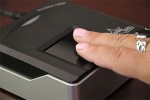The Future in Aviation And Airline Travel
The requirement for every passenger to present their boarding pass and identification document at multiple stages of the airport journey is perhaps the biggest obstacle to creating a seamless passenger experience. The creation of a “single passenger token” has been touted as a viable solution and the Aruba Happy Flow project, which involves Schiphol Group, KLM, the Dutch and Aruban governments as well as other stakeholders, and which leverages facial recognition technology as the key passenger identifier, is the standout example of a single token in action to date.
It has recently emerged, though, that Alaska Airlines has been working on its own single token pilot. Work has been going on to test the use of biometric technology, in this case fingerprint recognition technology, as the key identifier to simplify the airport experience. During the trial, select passengers on domestic flights from San Jose International Airport have been able to identify themselves at three checkpoints – bag drop, the security area and the boarding gate. Instead of presenting their boarding pass and government issued ID at each of the checkpoints, they could simply place their fingertips on a biometric reader, which identified the passengers by matching their fingerprint with the biometric information provided when they signed up to the scheme.
Speaking to FTE this week, Jerry Tolzman, Manager of Customer Research and Development at Alaska Airlines, explained that the trial was inspired by the introduction of fingerprint-based identification at the entrance of the carrier’s “Board Room” airport lounges. “85% of the people we asked signed up to this,” he said, “so we thought ‘hey, we should take this further’. The idea was to take it curb to seat and to hit the major interaction points.”
Tolzman told FTE that Alaska Airlines decided to pursue the use of fingerprint technology over any other form of biometric because passengers responded most positively to it. “With fingerprint technology, the passenger has to opt in,” he explained, which was a pre-requisite for the airline and its customers.
‘Overwhelmingly positive’ response
To enable the implementation of the fingerprint identification technology at the security checkpoint, Alaska Airlines teamed up with FTE Global 2015 exhibitor CLEAR, which already uses its “Fast Touch Technology” in CLEAR lanes at 12 US airports. CLEAR members can use these lanes to skip the queues at the security checkpoint.Tolzman revealed that more than 200 passengers took up the offer to participate in the pilot, which ran from mid-April until the end of July, and the response has been “overwhelmingly positive”. In surveys carried out among the participants, 80% said they were “delighted” with how the system worked, he said.
As the initial trial only finished last week, Alaska Airlines will now take time to review the findings before deciding what the next steps may be. “We still have a lot to figure out, but I think there’s something there,” Tolzman said. “There’s definitely room to simplify the airport experience”.
San Jose International was the ideal airport to trial the technology – it is after all known as “Silicon Valley’s Airport” – but given the response of many travellers, demand for such a simplified system is clearly more widespread. “The response has been great. We’ve had people saying to us ‘if you did this at my airport I’d definitely use it’,” Tolzman said.
It’s too early to say whether Alaska Airlines will be pursuing a fingerprint-based single token on a permanent basis, but this trial is certainly a step in the right direction in the context of the industry’s drive to simplify the airport experience for passengers. Travellers around the US will surely be hoping that the end of the trial does not mark the end of Alaska Airlines’ attempt to create a single passenger token.
FTE Global ‘Airport Futures’ session to explore single passenger tokens and biometrics
Source - FTE Global

No comments:
Post a Comment